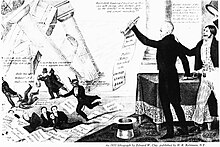Second Bank of the United States
The political support for the revival of a national banking system was rooted in the early 19th century transformation of the country from simple Jeffersonian agrarianism towards one interdependent with industrialization and finance.
[24][23] The political climate[24]—dubbed the Era of Good Feelings[25]—favored the development of national programs and institutions, including a protective tariff, internal improvements and the revival of a Bank of the United States.
[10][22][26] Southern and western support for a bank, led by Republican nationalists John C. Calhoun of South Carolina and Henry Clay of Kentucky, was decisive in the successful chartering effort.
[29] Subsequent efforts by Calhoun and Clay to earmark the bank's $1.5 million establishment "bonus", and annual dividends estimated at $650,000, as a fund for internal improvements, were vetoed by President Madison, on strict constructionist grounds.
[40] It was charged with restraining uninhibited private bank note issue—already in progress[40][41]—that threatened to create a credit bubble and the risks of a financial collapse.
[42] Simultaneously, the national bank was engaged in promoting a democratized expansion of credit to accommodate laissez-faire impulses among eastern business entrepreneurs and credit-hungry western and southern farmers.
[45][46] When the U.S. markets collapsed in the Panic of 1819—a result of global economic adjustments[40][47]—the bank came under withering criticism for its belated tight money policies—policies that exacerbated mass unemployment and plunging property values.
[49] Resigning in January 1819,[50] Jones was replaced by Langdon Cheves, who continued the contraction in credit in an effort to stop inflation and stabilize the bank, even as the economy began to correct.
[48][52] The financial crisis raised doubts among the American public as to the efficacy of paper money, and in whose interests a national system of finance operated.
The Supreme Court had affirmed its constitutionality in McCulloch v. Maryland, the 1819 case which Daniel Webster had argued successfully on its behalf a decade earlier,[57] the Treasury recognized the useful services it provided, and the American currency was healthy and stable.
[58][59] The bank first came under attack by the Jackson administration in December 1829, on the grounds that it had failed to produce a stable national currency, and that it lacked constitutional legitimacy.
[60][61][62] Both houses of Congress responded with committee investigations and reports affirming the historical precedents for the bank's constitutionality and its pivotal role in furnishing a uniform currency.
[64] Biddle made repeated overtures to Jackson and his cabinet to secure a compromise on the bank's rechartering (its term due to expire in 1836) without success.
[65][66] Jackson and the anti-bank forces persisted in their condemnation of the bank,[60][67] provoking an early recharter campaign by pro-bank National Republicans under Henry Clay.
[1][a] In hopes of extorting a rescue of the bank, Biddle induced a short-lived financial crisis[54][82] that was initially blamed on Jackson's executive action.
It was required to remit a "bonus" payment of $1.5 million, payable in three installments,[4] to the government for the privilege of using the public funds, interest free, in its private banking ventures.
[7][11][94] It was just this mechanism that the local private banks found objectionable, because it yoked their lending strategies to the fiscal operations of the national government, requiring them to maintain adequate gold and silver reserves to meet their debt obligations to the U.S.
[98] The hallmarks of the Greek Revival style can be seen immediately in the north and south façades, which use a large set of steps leading up to the main level platform, known as the stylobate.
The roofline is also topped by a balustrade, and the heavy modillions adorning the pediment give the First Bank an appearance more like a Roman villa than a Greek temple.
[100] The structure is open to the public free of charge and serves as an art gallery, housing a large collection of portraits of prominent early Americans painted by Charles Willson Peale and many others.
The Second Bank building was described by Charles Dickens in a chapter of his 1842 travelogue American Notes for General Circulation, Philadelphia, and its solitary prison: We reached the city, late that night.
The door was still tight shut, however; the same cold cheerless air prevailed: and the building looked as if the marble statue of Don Guzman could alone have any business to transact within its gloomy walls.
It was the Tomb of many fortunes; the Great Catacomb of investment; the memorable United States Bank.The stoppage of this bank, with all its ruinous consequences, had cast (as I was told on every side) a gloom on Philadelphia, under the depressing effect of which it yet laboured.




